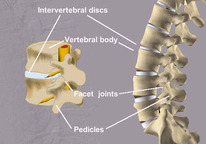Disc Injury

A disc injury and the associated protective muscle spasms can be one of the most painful and slow to heal back problems. The triad of bending, lifting, and twisting can be the most common cause of a disc injury. It can be due to a singular strenuous event, or gradual repetitive tasks. A reduction in a spinal joint's normal range of motion can also cause a healthy disc to deteriorate. Healthy discs have a high water content and help with shock absorption in the spine. They also allow for movement of one vertebra on the next. An unhealthy disc loses its water content, begins to thin, and can lead to early joint degeneration. Injury or trauma to the spine can cause discs to bulge, herniate, or even rupture. This can be painful and can put pressure on adjacent nerves.
Our approach to disc problems at Inner West Chiropractic Care is to help restore motion to the spinal joints around the disc. Various traction and distraction techniques can release pressure on the discs to provide relief. Reduction of inflammation and muscle spasms in the region can also provide relief. We can achieve good results with disc injuries, although they tend to be the slowest back problems to improve. Treatment commonly involves reduction of acute inflammation initially, followed by muscle release and spinal adjustments. As the condition stabilises and improves rehabilitation, stretching and strengthening exercises are often included in treatment protocol.
Our approach to disc problems at Inner West Chiropractic Care is to help restore motion to the spinal joints around the disc. Various traction and distraction techniques can release pressure on the discs to provide relief. Reduction of inflammation and muscle spasms in the region can also provide relief. We can achieve good results with disc injuries, although they tend to be the slowest back problems to improve. Treatment commonly involves reduction of acute inflammation initially, followed by muscle release and spinal adjustments. As the condition stabilises and improves rehabilitation, stretching and strengthening exercises are often included in treatment protocol.